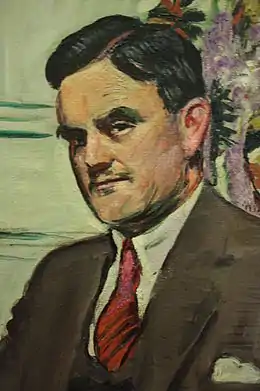Tom Honeyman
Thomas John Honeyman (10 June 1891 – 5 July 1971)[1] was a Scottish curator who was the director of the Glasgow Art Gallery.

Born in Gorbals, Glasgow, the son of engine driver Thomas Honeyman (1858–1934) and Elspeth Smith (1860–1937), Tom Honeyman studied medicine at Glasgow prior to service in the trenches during the First World War. He practised medicine in the East End of Glasgow, before moving to London to become an art dealer at the Lefevre Gallery. In London he met many great artists and when the Glasgow Corporation were looking for a new Director for their Kelvingrove Art Gallery they consulted Honeyman who eventually decided he might like the job. Taking up the post in 1939, he went on to make an enormous contribution to artistic and cultural life of Glasgow during his 15 years in the post. He greatly increased the profile of the Glasgow Art Galleries through clever publicity and successful exhibitions which, for example, brought queues to see Van Gogh's paintings.[2]
His art purchases were prudent and wise, buying works which have subsequently gained enormously in value. In 1952, Honeyman became famous for his purchase of Salvador Dalí's Christ of St. John of the Cross. A controversial purchase at the time, both because of its exceptional cost (£8,200) and contemporary style, it hung for many years in the Kelvingrove where it still hangs. It is one of the jewels of the city's art collection and has proven commercially remunerative, with displays and reproduction fees covering the original cost several times over. His reputation was such that he was able to attract several major gifts to the gallery, including that of Sir William Burrell (1861–1958) in 1944. Yet, Honeyman was forced to leave his post in 1954 having lost the support of his political master, the new chairman of the Glasgow Corporation Art Committee.
Passionate about the cultural life of Glasgow, Honeyman, with assistance from James Bridie, also founded the Glasgow Citizen's Theatre.[3] He was also involved in setting up the Scottish Tourist Board. Honeyman wrote an autobiographical book, largely memoirs of his time as Director of the Art Gallery, called Art and Audacity (Collins, 1971).[2]
Honeyman was the recipient of the 1943 St Mungo Prize, awarded to the individual who has done most in the previous three years to improve and promote the city of Glasgow.[4]
References
- Thomas John Honeyman, 1891-1971. The Correspondence of James McNeill Whistler. Archived from the original on 5 July 2013. Retrieved 26 June 2017.
- "TheGlasgowStory: 1950s to The Present Day: Personalities: Tom Honeyman". www.theglasgowstory.com. Archived from the original on 29 October 2015. Retrieved 10 April 2020.
- "The Citizens Theatre, 119 Gorbals Street, Glasgow". Archived from the original on 1 October 2019. Retrieved 13 September 2019.
- "TheGlasgowStory: A P Somerville". A P Somerville. The Glasgow Story. Archived from the original on 28 April 2019. Retrieved 5 August 2017.
| Academic offices | ||
|---|---|---|
| Preceded by John MacCormick |
Rector of the University of Glasgow 1953–1956 |
Succeeded by Rab Butler |